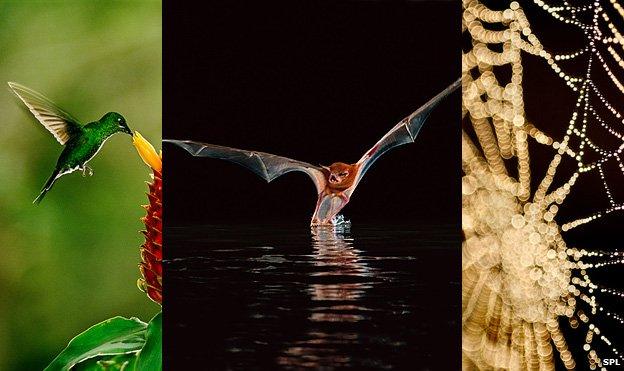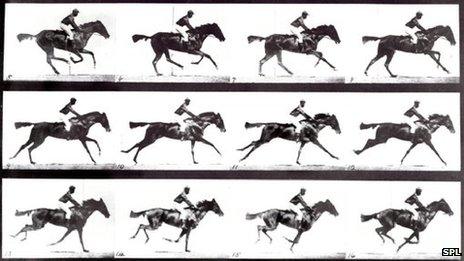Life in super slow-motion
- Published

High-speed cameras are being used to study birds, bats and even spider silk
A hummingbird hovers almost completely still in their air, feeding on nectar.
With every flap, its wings bend, flex and change shape. These subtle movements precisely control the lift its wings generate, making it an excellent hoverer.
Hummingbirds' main flight feathers slide as they flap, changing the shape and size of the wing and precisely controlling the lift its wings produce
That is why hummingbirds are a biological inspiration for engineers who want to make similarly diminutive robots capable of precision flight. Such micro-robots could be useful for the military or for search and rescue.
But a hummingbird flaps its wings up to 80 times every second. The only way to truly capture this motion is with cameras that will, in effect, slow down time.
That is why high-speed cameras have become such a mainstay of biology. And at this year's Society for Experimental Biology (SEB) meeting, external in Valencia, Spain, scientists presented some striking examples of its use.
Research teams are now using it to unveil the hidden information in a hummingbird's wingbeat, tracking the damage a single bullet does to a strand of natural silk and even to work out how dinosaurs moved.
Slowing down bullets
While the pictures on our televisions deliver 24 frames per second, high-speed cameras can capture hundreds and even thousands of frames in that same period.
Playing the resulting video back in super-slow motion reveals details that would otherwise be invisible to us.
"The idea of using high-speed cameras to resolve fast biological movements goes back more than a century," explained biologist Nicolai Konow, who presented his own work on flying bats.
The remarkable footage was achieved using a technique called X-ray reconstruction
Dr Konow's work combined X-rays with high-speed cameras to produce images of flying bats that (as well as making very creepy viewing) revealed the secrets of how the bats powered their flight.
Probably the earliest example of cameras revealing animal behaviour that was too fast for us to see was English photographer Eadweard Muybridge, who, in 1872, solved the mystery of whether all four of a horse's feet left the ground when it galloped.
With only glass plate cameras at his disposal, he used several in a carefully planned set-up where each camera was triggered by the horse itself as it galloped through and broke a thread.

Eadweard Muybridge's photographs solved the mystery of whether all four of a horse's feet left the ground when they galloped
Seeing each stride of a horse's gallop was revolutionary. But today a single high-speed camera can allow us to see events as fast as a speeding bullet - literally.
Beth Mortimer from the University of Oxford designed an experiment to fire plastic bullets into single strands of silk from a silkworm's cocoon.
Firing such fast projectiles into material is a technique engineers use regularly to see how jet engine components stand up to a mid-flight bird-strike.
"We're interested in seeing how the properties of the silk change as you deform them at very fast rates," explained Ms Mortimer.
"We can learn what kind of structures lead to what kind of properties. And that's important in terms of bio-inspired design - designing materials that have the same properties as the silk, which is incredibly strong and flexible."
Scientists fire plastic bullets into silkworm cocoon strands, to find out how these strong, flexible materials stand up to such high-speed projectiles.
Her Oxford colleague, Dr Clive Siviour added: "Our experiments have shown that silk is far superior to man-made fibres at absorbing energy under these conditions.
"By understanding how silk has evolved, we will be provided with the blueprints for stronger, tougher, sustainable fibres using nature's secrets."
Walking fish and dinosaurs
Even studying natural behaviour of animals that have been extinct for millions of years does not preclude researchers from using high-speed cameras.
Sandy Kawano and Richard Blob from Clemson University in the US have been trying to solve a mystery that is more than 300 million years. They have filmed the bizarre mudskipper fish, an amphibious creature that can move on land using its specially adapted limb-like fins.
The movement of the bizarre-looking mudskipper fish revealed clues about how fish fins evolved into limbs
"We're interested in understanding how [four-legged animals] were able to move onto land millions of years ago," Dr Kawano told BBC News. "The mudskipper fish is a useful animal because it shares many similarities to the fossil species that were important during this period of time."
As the strange little fishes dragged themselves along, the scientists filmed their movements and measured the forces their fins generated when they came into contact with the ground.
"High speed video has allowed us to reach new heights in understanding how the world works because it provides us the opportunity to look at movement at a finer scale," Dr Kawano added.
"It's important that we are able to properly capture what the animals are doing because even the slightest movement can influence how the animal behaves, whether it be moving across land or trying to catch its next meal."
Moving forward by a few hundred million years, British researchers are using the cameras to examine how dinosaurs might have walked.
Birds are the modern descendants of dinosaurs, so researchers hope to learn from how they walk
Dr Peter Falkingham from the Royal Veterinary College in London hopes eventually to extract information about dinosaurs' gait from their fossilised footprints.
"Making a footprint sounds really simple," said Dr Falkingham.
"But we really don't know what happens when a foot goes underneath the sediment surface, so we're using these high speed X-rays to understand sub-surface foot motion."
The team have filmed guinea fowl as they walked through sandy sediment. Matching the features of their gait to features in the resulting footprints, will enable to scientists to look for those same physical features in dinosaur tracks.
The scientist pointed out that there were engineering lessons that could be learned from how the dinosaurs - especially the very largest of the dinosaurs - moved around.
"T. rex was a nine-tonne biped (an animal that moved on two legs)," he told BBC News.
"That pushes biomechanics way beyond anything that's around now."
Studying birds, the modern descendents of dinosaurs, could help recreate the movements of these prehistoric giants.
- Published4 July 2013
- Published5 July 2013